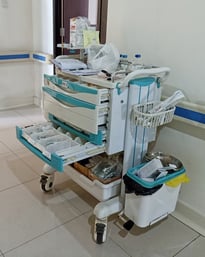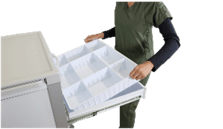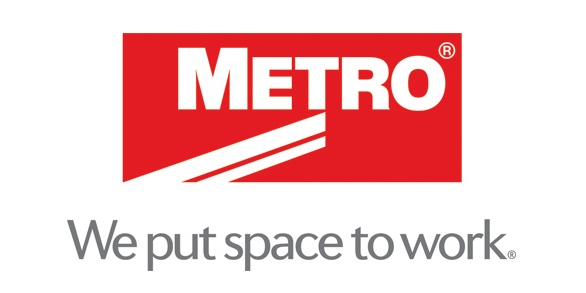In a landscape challenged by historic shortages of healthcare professionals, the inevitable staff burnout, and an increase in work-related injuries rooted in fatigue, medical carts are more important than ever.
Well-designed medical carts are invaluable assets for hospitals, clinics, and physician offices. Regardless of the type or purpose of the cart, immediately accessible medical supplies facilitate efficiency and by extension improved patient care.
This article will explore:
- What is a Medical Equipment Cart
- Types of Medical Equipment Carts
- How to Choose Medical Equipment Carts: Assessing the Needs
- Features to Look for in Medical Equipment Carts
- Factors to Consider When Buying a Medical Equipment Cart
- Medical Equipment Cart Manufacturers
- Medical Equipment Cart FAQs
What is a Medical Equipment Cart
 Medical carts are designed to organize the critical supplies, specialized instruments, medications, and computers required for patient care. They come in all:
Medical carts are designed to organize the critical supplies, specialized instruments, medications, and computers required for patient care. They come in all:
- are fabricated in stainless, aluminum, or MRI compatible material,
- and can be mobile or stationary.
Organized medical supplies minimize if not eliminate wasted energy retrieving items for treatments or procedures. This is invaluable in a climate challenged by nursing shortages. Optimized workflow and efficiency in the operating room or emergency room could be lifesaving.
The advent of medical computer carts helps reduce the number of errors recording patient information in electronic health records (EHR). Data, such vital signs, is often entered directly into the patient record at the time it is collected. This bypasses the risk of struggling to interpret illegibly written data later. Accurate, up to date information ensures continuity of care among medical professionals.
Types of Medical Equipment Carts
Medical carts of almost every variety are in view at every turn in a hospital. They are a staple in clinics or practice exam rooms.
Understanding the distinct purpose of the many types of medical carts is critical to configuring a cart for efficiency, versatility, and cost containment.
For example, the following are all medical equipment carts, but each serves a very defined purpose.
- anesthesia carts,
- case cart
- casting cart
- computer cart
- cylinder Cart
- EKG carts,
- emergency mobile medical cart
- laundry and linen cart
- medical isolation cart
- medication cart
- MRI compatible cart
- pediatric emergency medical cart
- Phlebotomy carts,
- Procedure cart
- Wound Care carts,
Although not true medical carts, computer carts, also known as mobile computing workstations, improve clinical workflow with access to critical patient records at the point of care. This facilitates uninterrupted patient care throughout and across nursing shifts.
How to Choose Medical Equipment Carts: Assessing the Needs
Understanding where, when, how, and by whom medical carts will be used is the first order of business when planning cart purchases. For example, medication carts and phlebotomy carts are in use almost every hour of the day. Emergency crash carts are used in unexpected emergency events. Departments like radiology may look for MRI compatible construction materials in medical supply carts.
Consider specific needs like the number and size of drawers necessary for the supplies/devices stored in the cart.
Requirements, such as the locking drawers for medication carts, should be evaluated as well.
Review the space available for carts not in use. Consider whether a cart will be stored under a counter or in a hallway, for example. Shorter or narrower carts are available specifically to address logistics like these.
While they are fewer and farther between, applications of stationary carts do exist. Explore the need for mobile vs stationary carts in your healthcare environment.
Features to Look for in Medical Equipment Carts
With the where, when, how, and who identified, the next order of business is understanding what features make great medical equipment carts.
Although not applicable to every use or implementation the following features are worthy of exploration.
Durability and Construction.
Medical carts will be banged, bumped, and generally see hard use. Therefore, it is important to consider construction materials (steel, aluminum, or polymer) and the construction itself.
- Are joints and seams welded?
- Will the materials withstand frequent cleaning with harsh cleaners?

Size and Configuration.
Medical cart manufacturers offer standard carts that include popular heights and must-have features. For example, carts sized to fit under counters offer the benefit of out of the way storage. When in use these shorter carts also offer additional workspace for the healthcare provider during an exam or procedure.
Many manufacturers also offer customization that includes optional drawer configurations and peripherals like:
- sharps containers,
- chart holders,
- wastebaskets,
- and side shelves.
Be sure to ask about other customization options.
Mobility and Maneuverability
The primary purpose of any mobile medical cart is to make supplies, instruments, and equipment immediately accessible to healthcare professionals where and when they are needed. For this reason, mobility and maneuverability are paramount considerations.
Look for large diameter caster wheels to reduce the level of exertion and force needed to control the cart once it is in motion. An added benefit of this feature is the ability to maneuver medical carts over elevator thresholds, carpet, and debris that may be on the floor.
Be sure to ask about lightweight aluminum construction. This works in conjunction with caster wheels to make moving medical equipment carts easy. It also limits the risk of injury to caregivers.
Ergonomics
Today’s medical carts are lightweight, agile, and ergonomically engineered to decrease fatigue, stress, and injuries caused by excessive bending, twisting, pushing, and pulling.
Consider adding handles to multiple sides of mobile carts to help with maneuverability by limiting the exertion and force needed to move the cart.
Height adjustable handles minimize the risk factor for musculoskeletal disorders prevalent in the healthcare workplace by allowing staff to push with their hands, arm, or shoulder.
Storage and Organization
Medical carts are designed specifically to store and organize supplies and equipment.

Look for optional drawer sizes. Supplies and tools come in all sizes and shapes. Most manufacturers offer custom configurations for the number and size of drawers.
Ask about accessories such as overhead shelves, drawer dividers, and brackets for peripherals like waste receptacles and cardiac boards. These options are invaluable.
Security and Locking
Physical security options for medical equipment carts range from simple break away tabs and key locks to electronic keypads, or more sophisticated RFID technology. These are an important feature to consider for preventing unauthorized entry to carts. 
In some instances, mobile carts may contain medications that fall under state and federal drug laws. These laws have clearly defined requirements for storage and accountability. Drawers that automatically lock on close are a popular security feature that satisfies medication storage laws.
Electrical Outlet and Connectivity
Powered medical carts, whether through electrical cables or battery packs, bring health records and vital diagnostic equipment to the patient’s bedside.
Look for accessories such as battery packs or power strips with long electrical cords if the cart requires onboard power for computers or medical equipment.
Cleanliness and Infection Control
Medical carts should not have:
- “nooks and crannies” that can harbor pathogens,
- hard edges,
- or other non-flat surfaces that make cleaning difficult.
Look for carts with smooth work surfaces with minimal plastic, and antimicrobial powder-coated metal or polymer.
Surface materials should also be able to withstand the rigors of frequent cleaning with sanitizing chemicals.
Weight Capacity and Load Distribution
Balanced medical carts are best. Ideally the load of drawers and accessories should be spread evenly across the base.
When this cannot be achieved, transporting a deceptively heavy ECG for example, look for a medical equipment cart that allows a heavier load to be placed closer to the front or center.
Check the manufacturer’s weight specifications if the cart will store and transport medical equipment with weight.
Quiet Operation
Look for medical carts that feature quiet-close drawer glides. Quiet-close glides are engineered with spring activated damper mechanisms that pull the drawers shut softly and silently.
These glides all but eliminate the noise associated with accessing supplies.
A quiet operation offers more peace and quiet to patients. By extension, quiet-close drawer guides can contribute to higher patient satisfaction scores.
Factors to Consider When Buying a Medical Equipment Cart
In addition to carefully curating a selection of medical cart features for the most benefit, there are other factors to consider during the process of buying medical equipment carts.
The cost of the assets is an overriding consideration, followed by the quality of the equipment and finally, the maintenance required to keep the carts in use.
Cost
In correlation with the wide range of shapes, sizes, and available peripherals, there is an equally wide range of retail prices for mobile carts.
However, the purchase price is not the only cost consideration. A thorough cost analysis should consider:
- the indirect cost of disposal at end of life,
- sustainability of the construction materials,
- the cost of downtime should the cart become unusable,
- and unfortunately, the costs associated with a staff member being injured because of a faulty cart.
While indirect costs may be hard to quantify, the correlation between the retail price of the medical equipment cart and the quality is measurable.
Quality
High quality medical carts should be a balanced mix of:
- lightweight aluminum with smooth edges,
- easy to clean surfaces,
- stainless steel for components under significant stress, and
- minimal plastic surfaces that can crack and become a breeding ground for MRSA or other pathogens.
Ergonomic features, ease of maneuverability whether the cart is being pulled or pushed, and a minimal footprint contribute to the overall quality of hospital carts.
Just as it is standard practice for hospitals and clinics to hire the best staff, it should also be standard to purchase quality equipment to support that same highly qualified staff.
Maintenance
Hospital carts are more than a stack of drawers on four wheels. In many cases mobile medical carts are sophisticated workstations that not only carry consumable supplies but electronic equipment, and computer hardware.
When configuring a cart for a specific purpose consideration should be given to the maintenance of each aspect of a medical cart. For example,
- If the cart hosts a computer for point of care information, how will computer hardware be kept clean?
- How often will EHR software be updated? By whom?
- Who is responsible for updating users’ codes for keypad locking systems?
- How often do casters need to be replaced and where do you source replacement casters?
- Are replacement drawers and other parts readily available?
- Does the manufacturer offer an annual preventive maintenance contract? Do they have repair technicians available?
Far from an exhaustive list, these are a sampling of maintenance points for consideration when purchasing mobile medical equipment carts.
Joint Commission Accreditation or Certification
If a healthcare facility is pursuing accreditation or certification from The Joint Commission (TJC) look for medical equipment cart features favored by TJC. For example, breakaway locks for code carts and solid bottom shelves for wired supply carts. The color of the cart, red for code carts for example, is also a feature TJC looks for when evaluating medical equipment carts in healthcare facilities. Learn more about TJC at jointcommission.org.
Medical Equipment Carts by Manufacturer
CME is dedicated to offering quality medical equipment carts from the leading manufacturers in the industry.
Explore the CME Corp. online shop for a complete selection of carts.
Our expert account managers will work with you and the manufacturers’ representatives to configure medical equipment carts that are the perfect fit for your facility, at the best price for your budget.
CME can also, in most cases, receive, inspect, assemble optional accessories, and deliver your medical equipment carts when it is convenient for you.
Learn more about CME’s one-of-a-kind direct-to-site logistical services with a visit to our website www.cmecorp.com.
CHAT with us to learn more.
It could be said that medical equipment carts are the backbone of hospitals, clinics, and even private practice offices. They:
- improve efficiency and patient care with mobile, organized, medical supplies and equipment,
- foster a seamless workflow among caregivers, and
- mitigate injuries to healthcare providers.
In a landscape with an aging population, increasing healthcare needs, and staffing shortages, medical carts are a remedy for the challenges faced by the healthcare industry.
Medical Equipment Cart FAQs
Are medical equipment carts customizable?
Yes! Medical equipment carts come in a variety of heights. 21”. 24”, 27” and 30” are the most common. Drawers, usually in depths of 3”, 6” or 9” can be configured as needed. Add in drawer trays and dividers and your cart is as unique as your facility.
Are medical equipment carts delivered assembled?
Yes. CME ensures that carts are delivered with all accessories installed. Prior to delivery CME will inspect carts to ensure there is not any shipping damage. If there is, CME will correct the problem directly with the manufacturer.
How should a medical cart be organized?
The organization of medical carts is directly correlated to the purpose of the cart. For example, a Phlebotomy cart will be organized very differently than an Emergency Crash Cart or Medication Cart.
Typical medical carts are multi drawered and contain standard supplies organized by purpose.
About CME: CME Corp is the nation’s premier source for healthcare equipment, turnkey logistics, and biomedical services, representing 2 million+ products from more than 2,000 manufacturers. With two corporate offices and 35+ service centers, our mission is to help healthcare facilities nationwide reduce the cost of the equipment they purchase, make their equipment specification, delivery, installation, and maintenance processes more efficient, and help them seamlessly launch, renovate and expand on schedule.

















